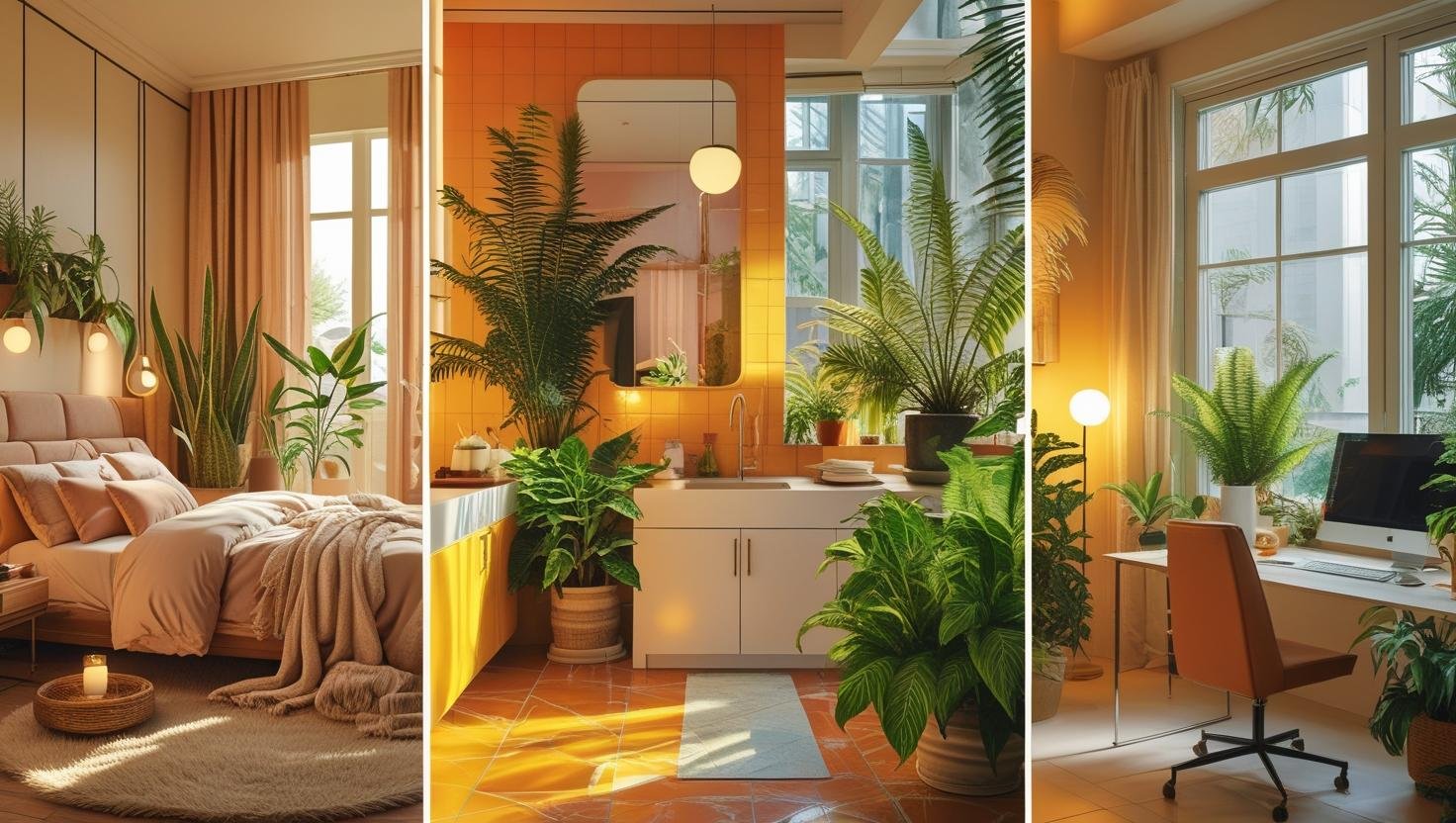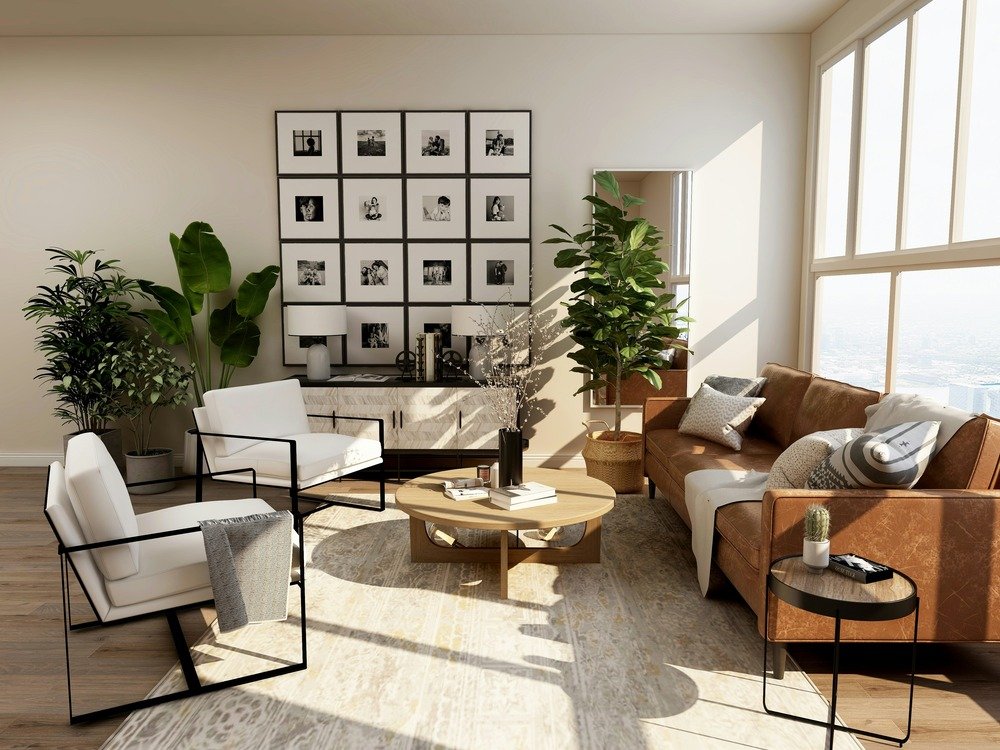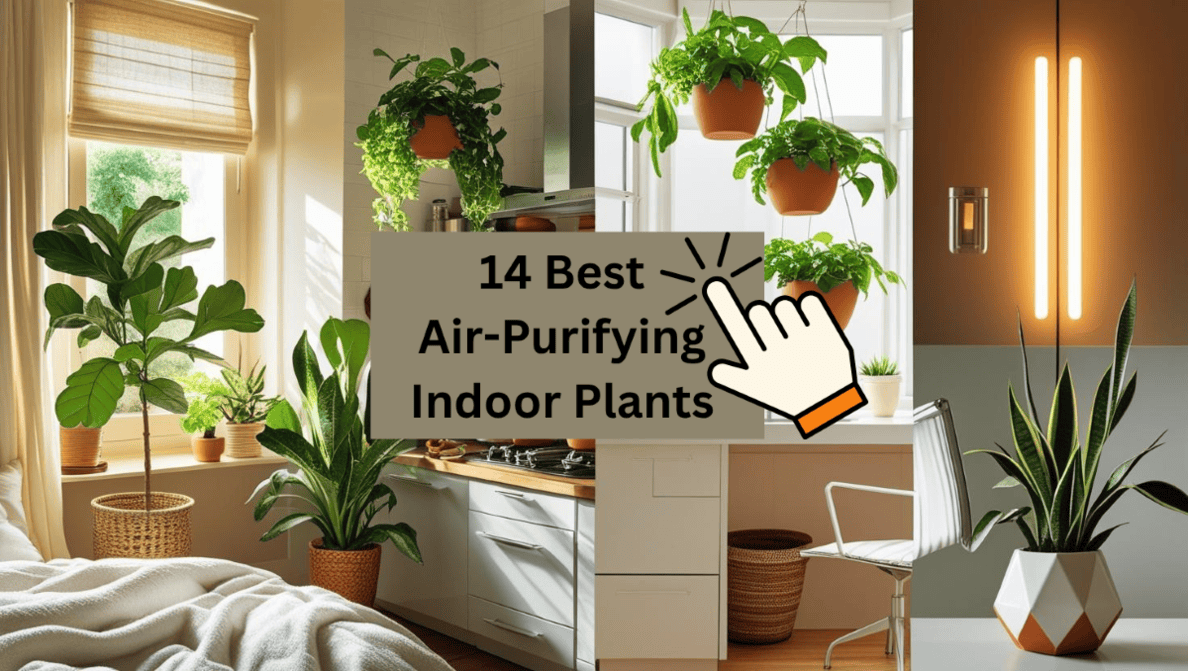Table of Contents
Introduction
Indoor pollution is a silent issue that affects our everyday lives. With toxins like formaldehyde, benzene, and carbon monoxide present in furniture, wall paints, synthetic materials, and cleaning products, the air inside our homes is often more polluted than the outside air. Thankfully, certain houseplants are nature’s own air purifiers, capable of detoxifying the air and boosting overall indoor wellness.
In this article, we present-
- A quick line-up of the 14 Best Air-Purifying Indoor plants
- Bite-sized care and placement tips for each species
- Easy styling ideas for every room
- Expert insights plus an at-a-glance care cheat sheet
These plants not only enhance your decor but also promote a healthier living environment.
Quick-Glance Line-Up
| S.No | Plant | Notable Pollutants Removed | Care in One Line |
|---|---|---|---|
| 1 | Spider Plant | Formaldehyde, Carbon Monoxide | Bright, indirect light; weekly watering |
| 2 | Snake Plant | Benzene, Formaldehyde, Trichloroethylene | Tolerates low light; water sparingly |
| 3 | Rubber Plant | Formaldehyde | Bright light; keep soil slightly moist |
| 4 | Peace Lily | Formaldehyde, Benzene, Ammonia | Medium light; keep soil evenly moist |
| 5 | Areca Palm | Xylene, Toluene | Bright, filtered light; consistent moisture |
| 6 | English Ivy | Benzene, Mold Spores | Bright light; keep soil moist |
| 7 | Boston Fern | Formaldehyde | High humidity; consistently moist soil |
| 8 | Golden Pothos | Formaldehyde, CO | Low-to-bright light; water when dry |
| 9 | Chinese Evergreen | Benzene, Formaldehyde | Low light; allow topsoil to dry |
| 10 | Aloe Vera | Benzene, Formaldehyde | Bright light; drought-tolerant |
| 11 | Bamboo Palm | Formaldehyde, Xylene | Medium light; keep soil moist |
| 12 | ZZ Plant | Benzene, Toluene | Low light; water every 10–14 days |
| 13 | Dracaena | Formaldehyde, benzene, trichloroethylene | Bright but indirect light |
| 14 | Philodendron | Formaldehyde | Bright, Keep soil dry out between watering |

Why Choose Air-Purifying Plants?
I. The Science Behind the Hype
Indoor greenery really did start its fame tour at NASA. In a 1989 laboratory study, researchers sealed common houseplants in chambers filled with benzene, formaldehyde, and trichloroethylene and found that roots, soil microbes, and leaves together pulled significant amounts of each toxin out of the air (ntrs.nasa.gov)
Fast-forward to real-world follow-ups: a 2022 University of Birmingham/RHS experiment showed that five humble peace lilies or corn plants in a ventilation-poor 15 m² office could trim nitrogen-dioxide levels by about 20 % in just an hour(birmingham.ac.uk)
While plants are not magic vacuum cleaners, when placed strategically about two medium-sized pots per 9 m² as per NASA’s guidelines, they act as quiet, natural filters that complement your home’s ventilation system.
II. Health Upsides You Can Feel
| Benefit | How Plants Help | What the Research Says |
|---|---|---|
| Easier breathing | Leaves and their microbiome absorb VOCs and airborne NO₂ | NASA & Birmingham studies above |
| Lower stress & BP | Simply potting or tending a plant suppresses sympathetic-nervous-system activity | Controlled crossover trial, Journal of Physiological Anthropology (2015) (jphysiolanthropol.biomedcentral.com) |
| Sharper focus | Classrooms/offices with greenery report higher concentration & productivity | Pandemic-era meta-review, TIME health feature (2023) (time.com) |
| Mood lift | Caring for something living releases dopamine and instils a sense of agency | Survey of 1 000+ plant parents during COVID-19 (IJIP, 2023) (ijip.in) |
III. Aesthetic & Emotional Value
Instant decor upgrade: A trailing pothos softens hard tech edges; a rubber tree turns an empty corner into a statement.
Biophilic design: Humans evolved outdoors. Adding organic shapes, shifting light, and a hit of chlorophyll taps that ancient preference and makes rooms feel bigger and calmer.
Conversation starter: Plants humanize a space, visitors ask about the variety, share tips, and voila, a micro-community.
Top 14 Indoor Plants for Natural Air Purification
Below are some of the best indoor plants known for their air-purifying abilities –
1. Spider Plant (Chlorophytum comosum)
- Air-Purifying Superpower: Tackles formaldehyde, benzene, xylene, even a bit of carbon monoxide.
- Sweet Spot: Hanging baskets or shelves in bright, indirect light, perfect for kitchens and kids’ rooms.
- Care Cheat-Sheet: Water when the top 2 cm dries; ordinary potting mix; 18 – 27 °C.
- Bonus Nugget: Pet-safe and shoots out baby “spiderettes” you can root in a glass of water for free plants.
2. Snake Plant (Sansevieria trifasciata)
- Air-Purifying Superpower: Excellent at filtering out formaldehyde, benzene, trichloroethylene, and nitrogen oxides, especially at night.
- Sweet Spot: Any low-light corner or bedside table (it releases oxygen after dark).
- Care Cheat-Sheet: Ignore it, water monthly; succulent soil; 15 – 29 °C.
- Bonus Nugget: Virtually indestructible but mildly toxic to pets, so elevate if you have chewers.
3. Rubber Plant (Ficus elastica)
- Air-Purifying Superpower: Mops up formaldehyde like a champ.
- Sweet Spot: Bright living-room corner with morning sun.
- Care Cheat-Sheet: Keep soil lightly moist; free-draining peat-based mix; 18 – 26 °C; wipe the glossy leaves monthly.
- Bonus Nugget: Dramatic upright silhouette, style it as a solo statement tree.
4. Peace Lily (Spathiphyllum)
- Air-Purifying Superpower: Removes benzene, trichloroethylene, and formaldehyde.
- Sweet Spot: Low-light bathrooms or offices; loves humidity.
- Care Cheat-Sheet: Water when leaves droop slightly; rich, well-aerated soil; 18 – 24 °C.
- Bonus Nugget: Mildly toxic to pets but rewards you with elegant white blooms most of the year.
5. Areca Palm (Dypsis lutescens)
- Air-Purifying Superpower: Targets formaldehyde, xylene, and toluene while boosting humidity.
- Sweet Spot: Bright corners near east- or south-facing windows.
- Care Cheat-Sheet: Keep soil evenly moist; peat-perlite mix; 18 – 30 °C; mist in dry seasons.
- Bonus Nugget: Non-toxic to pets and adds an instant tropical vibe.
6. English Ivy (Hedera helix)
- Air-Purifying Superpower: Reduces airborne fecal particles and formaldehyde.
- Sweet Spot: Cool, bright windowsills or top of bookshelves where it can trail.
- Care Cheat-Sheet: Let top 2 cm dry out; loamy soil; 10 – 21 °C.
- Bonus Nugget: Not pet-friendly but fantastic for sculpting around indoor trellises.
7. Boston Fern (Nephrolepis exaltata)
- Air-Purifying Superpower: Absorbs formaldehyde and airborne molds.
- Sweet Spot: Hanging basket in a steamy bathroom or shaded balcony.
- Care Cheat-Sheet: Keep soil consistently damp; high humidity; 16 – 24 °C.
- Bonus Nugget: Frilly fronds soften hard edges in minimalist interiors.
8. Golden Pothos (Epipremnum aureum)
- Air-Purifying Superpower: Removes formaldehyde, benzene, and toluene, nicknamed “cubicle clean-up crew.”
- Sweet Spot: Any light except direct sun; thrives under fluorescents.
- Care Cheat-Sheet: Let soil dry halfway; standard potting mix; 15 – 30 °C.
- Bonus Nugget: Forgiving of neglect; train along walls with clear hooks for living art.
9. Chinese Evergreen (Aglaonema)
- Air-Purifying Superpower: Destroys benzene and formaldehyde, even in low light.
- Sweet Spot: Dim hallways or desk corners.
- Care Cheat-Sheet: Water when half the pot dries; well-draining soil; 18 – 27 °C.
- Bonus Nugget: Comes in speckled pinks and silvers use contrasting pots for extra pop.
10. Aloe Vera
- Air-Purifying Superpower: Clears formaldehyde and benzene from paints and cleaners.
- Sweet Spot: Sunny kitchen ledge; doubles as a first-aid kit.
- Care Cheat-Sheet: Cactus mix; water deeply, then forget until the soil dries out completely; 13 – 27 °C.
- Bonus Nugget: Snap a leaf to soothe minor burns, an instant conversation starter.
11. Bamboo Palm (Chamaedorea seifrizii)
- Air-Purifying Superpower: Filters benzene, trichloroethylene, and formaldehyde while humidifying.
- Sweet Spot: Bright, indirect-light corners, great near seating areas.
- Care Cheat-Sheet: Light, regular watering; rich, peat-based mix; 18 – 27 °C.
- Bonus Nugget: Non-toxic and arches beautifully without crowding the furniture.
12. ZZ Plant (Zamioculcas zamiifolia)
- Air-Purifying Superpower: Handles xylene, toluene, and tiny airborne particulates.
- Sweet Spot: Windowless corridors, dim bedrooms, anywhere light is scarce.
- Care Cheat-Sheet: Water monthly; fast-draining mix; 15 – 29 °C; wipes dust easily off waxy leaves.
- Bonus Nugget: Architectural look, but all parts are mildly toxic, keep out of nibbling range.
13. Dracaena (Dracaena deremensis and others)
- Air-Purifying Superpower: Tackles xylene, trichloroethylene, and formaldehyde.
- Sweet Spot: Bright corners where its cane-like stems add height.
- Care Cheat-Sheet: Allow top 3 cm to dry; loose, chunky soil; 18 – 26 °C.
- Bonus Nugget: Many varieties, such as ‘Warneckei’, ‘Marginata’, ‘Janet Craig’, pick leaf stripes to match your palette.
14. Philodendron (heart-leaf & hybrids)
- Air-Purifying Superpower: Absorbs formaldehyde from particleboard furniture.
- Sweet Spot: Bookshelf edge or hanging pot with medium light.
- Care Cheat-Sheet: Water when top 2 cm dry; peat-rich soil; 18 – 29 °C.
- Bonus Nugget: Fast trailing growth, ideal for creating an indoor “green waterfall.”
Quick-Glance Care Matrix
| Plant | Light | Water | Pet-Safe? |
|---|---|---|---|
| Spider | Medium | Weekly | non-toxic |
| Snake | Low-bright | Monthly | keep away from pets & kids |
| Rubber | Bright | Weekly | keep away from pets & kids |
| Peace Lily | Low-medium | Weekly | keep away from pets & kids |
| Areca Palm | Medium-bright | 2× week | non-toxic |
| Boston Fern | Low-medium | Damp | non-toxic |
| English Ivy | Bright | 5-7 days | keep away from pets & kids |
| Aloe Vera | Bright | 3-4 weeks | keep away from pets & kids |
| Bamboo Palm | Medium | Weekly | non-toxic |
| Chinese Evergreen | Low | 10 days | keep away from pets & kids |
| Dracaena | Medium | 10 days | keep away from pets & kids |
| Philodendron | Medium | Weekly | keep away from pets & kids |
| Pothos | Low-medium | 10 days | keep away from pets & kids |
| ZZ Plant | Low | Monthly | keep away from pets & kids |
Placement Ideas for Air-Purifying Indoor Plants
Want to know where to place air-purifying plants in your home for maximum health and aesthetic benefits? Here is a room-by-room breakdown that will help you align your greenery with airflow, lighting, and decor.

I. Room-by-Room Guide
| Room | Best Plant Placement | Why It Works | Top Plants for the Space |
|---|---|---|---|
| Living Room | Beside bright but filtered windows or grouped in a corner, coffee-table cluster | Promotes oxygen flow + brightens décor | Rubber Plant, Areca Palm, Monstera |
| Bedroom | Night-stand, low bench near east-facing window | Supports better sleep with oxygen release | Snake Plant, Peace Lily, Aloe Vera |
| Kitchen | Floating shelves, top of fridge, sunny sill | Loves warmth and light; absorbs cooking fumes | Spider Plant, Pothos, English Ivy |
| Bathroom | Hanging from the ceiling or on high shelves | Benefits from humidity; thrives in low light | Boston Fern, ZZ Plant |
| Home Office | Desk corner, book-case nook, mobile plant cart | Improves focus + filters VOCs from electronics | Philodendron, Chinese Evergreen |
II. Indoor Plant Lighting: Match Plants to Natural Light Levels
Proper lighting can make or break your plant’s air-purifying powers. Here is how to determine the right light for houseplants:
1. Map the Light First
- Bright Direct Light: South-facing windows; 4–6 hours of full sun.
- Bright Indirect Light: 1–2 meters from window or behind sheer curtains.
- Medium Light: East/west windows; morning or afternoon light.
- Low Light: North-facing rooms or areas lit by lamps.
2. Plants Matching
- Low Light: ZZ Plant, Pothos, Snake Plant
- Medium Light: Peace Lily, Rubber Plant, Spider Plant
- Bright Indirect Light: Areca Palm, Boston Fern, Monstera
- Full Sun: Aloe Vera, English Ivy
3. Useful Tips
- Rotate pots 90° weekly for even growth.
- Use inexpensive light-meter apps or the “hand-shadow” test: crisp shadow = bright; fuzzy = medium; none = low.
- Equip low-height rooms with full-spectrum LED grow bulbs on a 12-hour timer.
III. Home Decor with Plants
Want to decorate with indoor plants while boosting air purification? Here is how to blend form with function:
- Decorative Planters: Choose ceramic, clay, or woven baskets. Use breathable materials with drainage holes.
- Hanging Planters: Ideal for bathrooms, kitchens, or small rooms. Improves airflow and saves space.
- Plant Stands & Ladders: Layer heights for visual balance and better light exposure.
- Mobile Plant Carts: Move plants closer to windows during the day, great for home offices.
- Humidity Zones: Group tropical plants (e.g., ferns, peace lilies) with pebble trays for microclimates.
- Spacing Tips: Leave space between plants to avoid mold, and clean leaves monthly to optimize air filtration.

Conclusion
Adding air-purifying plants to your indoor space is not just a design choice; it is a great way to enhance your lifestyle. From the low-maintenance charm of the snake plant to the vibrant energy of the rubber plant, these green companions not only freshen your air but also uplift your mood and improve your living environment.
Whether you are adding a spider plant to your kitchen or a peace lily to your bedroom, each plant offers unique benefits, provided it is given a little care and attention. Remember, it is not just about greenery, it is about taking the first step.
Ready to bring nature indoors? Start with one plant. Watch it thrive. Then, slowly grow the jungle inside your home. Your lungs and your brain will thank you.
Tell us – What plant are you bringing home first? Share your thoughts in the comments below.
FAQs
Q1. Do indoor plants really purify the air?
Ans. Yes, several scientific studies, including NASA’s Clean Air Study, confirm that certain indoor plants can remove harmful toxins such as formaldehyde, benzene, and trichloroethylene from the air. However, while plants contribute to cleaner indoor air, they work best when combined with proper ventilation and other air purification methods.
Q2. Which indoor plant purifies the air the fastest?
Ans. The Spider Plant, Snake Plant, and Peace Lily are among the fastest and most effective at filtering airborne toxins. They’re also low-maintenance, making them ideal for beginners.
Q.3 How many air-purifying plants do I need for a room?
Ans. A general recommendation is to have at least one medium-sized plant per 100 square feet for noticeable air purification. Larger rooms may benefit from multiple plants placed strategically.
Q4. Are air-purifying plants safe for pets?
Ans. Not all air-purifying plants are pet-friendly. For example, Peace Lily, Aloe Vera, and Snake Plant can be toxic to cats and dogs if ingested. Pet-safe alternatives include the Areca Palm and Spider Plant.
Q5. Can these plants survive in low light conditions?
Ans. Yes, many air-purifying plants such as the ZZ Plant, Snake Plant, and Pothos thrive in low to moderate light, making them suitable for offices or dim corners of your home.
Q6. How often should I water air-purifying plants?
Ans. Watering needs vary by plant type, but most air-purifying houseplants prefer to dry out slightly between waterings. Overwatering is a common issue, so it is important to check the soil moisture before each watering.

